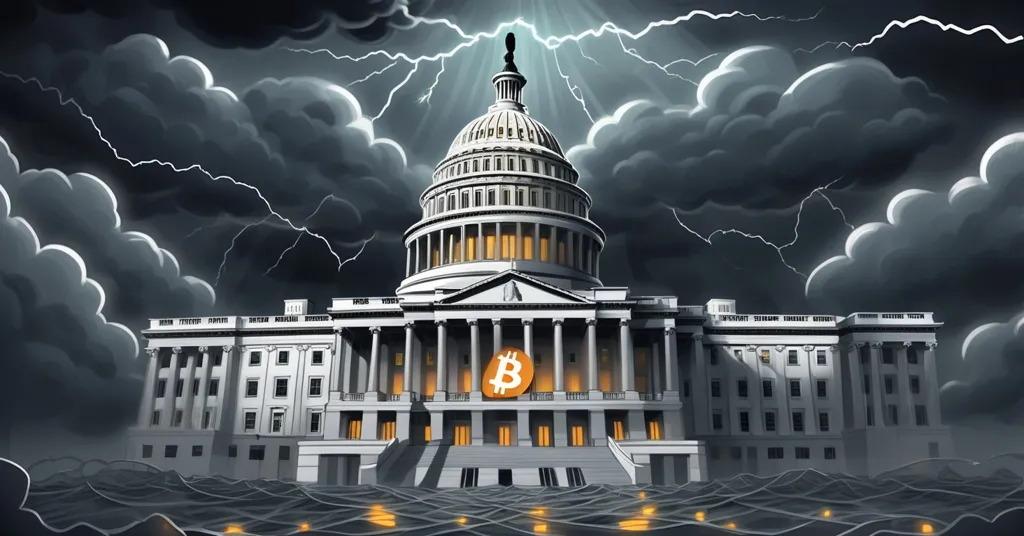U.S. Shutdown Threat: BLS Data Halt Could Boost Bitcoin Amid Economic Chaos

BLS Data Shutdown Looms: Economic Blackout and Bitcoin’s Moment to Shine
The U.S. government is teetering on the edge of a shutdown, with a 74% chance by Wednesday according to prediction platform Kalshi, and the consequences could plunge economic data into darkness while testing Bitcoin’s mettle as a safe haven. The Bureau of Labor Statistics (BLS), a cornerstone of the Department of Labor, will halt all critical releases—including Friday’s pivotal jobs report—if funding collapses, leaving markets, policymakers, and the Federal Reserve scrambling in a fog of uncertainty.
- Shutdown Risk: 74% likelihood of a U.S. government shutdown by Wednesday, per Kalshi.
- Data Freeze: BLS to stop all economic reports, including nonfarm payrolls, jobless claims, and CPI.
- Crypto Stakes: Economic uncertainty could spike volatility for Bitcoin and altcoins as investors react.
BLS Data Halt: What’s at Stake for Markets and Beyond
As the deadline looms, the BLS has made it clear in a detailed 73-page contingency plan from the Department of Labor that a shutdown means a complete operational standstill. We’re talking no nonfarm payrolls report this Friday, which gives a snapshot of job gains or losses across most industries (excluding farming), and no weekly initial jobless claims updates every Thursday, which track how many folks are filing for unemployment. Perhaps most critically, the Consumer Price Index (CPI), set for October 15 and measuring inflation through price changes in everyday goods and services, won’t see the light of day. That’s the last inflation reading before the Federal Reserve’s October 28-29 meeting—a meeting that could set the tone for interest rates and, by extension, market sentiment across the board, including crypto.
For the uninitiated, these reports aren’t just bureaucratic busywork. They’re the lifeblood of economic forecasting—traders bet on them, economists analyze them, and the Fed uses them to decide whether to pump the brakes or hit the gas on monetary policy. Without this data, the Fed might as well flip a coin for their next rate decision—heads for a cut, tails for a hike. And it’s not just a delay; the BLS will cease all active data collection and freeze website updates, meaning even when the lights come back on, future reports could be skewed or delayed further due to missing pieces of the puzzle. As the contingency plan bluntly states:
“BLS will suspend all operations. Economic data that are scheduled to be released during the lapse will not be released.”
This data blackout is a gut punch at a time when clarity is everything. Imagine trying to trade Bitcoin or Ethereum without knowing if inflation is roaring or if unemployment is spiking. It’s like stepping into a cage fight blindfolded—you’re swinging, but you’ve got no idea where the hits are coming from.
Political Chaos and Economic Fragility: A Perfect Storm
The timing of this potential shutdown couldn’t be worse. The U.S. economy is already wobbling with slowing job growth and sticky inflation, while political fractures are deeper than ever. President Donald Trump has called Congressional leaders to the White House for a last-minute push to dodge the Wednesday deadline, even threatening mass firings of federal workers if funding falls through. Let’s be real—governments can’t even keep their own house in order, so why should we trust them with the financial future? For more on the impending halt of critical data like the jobs report, check out this detailed coverage on the BLS shutdown.
Historically, markets have often yawned at shutdowns, treating them as temporary political theater. Think back to 2013 or 2018-2019—brief disruptions, quick resolutions, minimal long-term damage. But this feels different. The current economic fragility, paired with a polarized Washington, ramps up the risk of real fallout. Wall Street heavyweights are sounding the alarm, with Moody’s having already downgraded the U.S. credit rating from Aaa to Aa1 in May over political dysfunction and fiscal concerns. They’ve warned of further cuts, stating:
“The rating also could be downgraded if policy effectiveness or the strength of institutions were to erode to such a degree that materially weakens the sovereign’s credit profile.”
JPMorgan’s trading desk has flagged a “tail risk” of another downgrade if this shutdown drags on. Think of a credit rating drop like a hit to your personal credit score—suddenly, borrowing gets pricier. For the U.S., this means higher Treasury yields, ballooning government borrowing costs, and a potential drag on future earnings across markets. While some, like FWDBONDS chief economist Chris Rupkey, call a downgrade a mere “technicality” for Treasury markets, bond traders are reportedly looking to incoming Treasury Secretary Scott Bessent to intervene if chaos escalates.
How a Government Shutdown Could Impact Bitcoin and Crypto Markets
For the crypto crowd, this economic uncertainty is a double-edged sword. Bitcoin often dances to the tune of macro chaos—sometimes surging as a hedge against centralized failures, other times tanking as a risk asset when investors flee to cash. Look at 2020 during the COVID market crash: Bitcoin initially plummeted alongside stocks, only to rocket to new highs as stimulus flooded the system and distrust in traditional finance grew. On-chain data during past crises often shows whale movements or exchange inflows as early signals of sentiment shifts—something to watch if this shutdown hits.
But let’s not stop at Bitcoin. Altcoins and DeFi could also feel the heat. If Treasury yields spike from a credit downgrade, we might see a flight to stablecoins like USDT or USDC as investors seek shelter. Ethereum’s DeFi protocols, offering decentralized lending and yield farming, could see a bump in activity if traditional finance stumbles—though let’s be honest, they come with their own risks of smart contract bugs and liquidity crunches. Bitcoin remains the ultimate middle finger to centralized chaos, but Ethereum and others fill niches BTC doesn’t aim to touch.
Still, a counterpoint worth chewing on: Bitcoin’s decentralized, 24/7 nature means it doesn’t care if the BLS servers are offline. Unlike stocks or bonds tied to government data, BTC keeps chugging along, borderless and censorship-resistant. Could this resilience mean it decouples somewhat from traditional market panic? Maybe—but history suggests volatility is the only guarantee. We won’t peddle fake price targets here—Bitcoin’s reaction to a shutdown is anyone’s guess, but expect a wild ride either way.
Decentralization’s Neon Sign: Centralized Systems Are Failing
If there’s a silver lining for crypto enthusiasts, it’s that this potential shutdown screams the flaws of centralized systems. When a government can’t agree on funding and a vital agency like the BLS grinds to a halt, it’s a glaring reminder of why we need trustless, permissionless alternatives. Bitcoin was born from the ashes of the 2008 financial crisis as a response to centralized mismanagement, and events like this only reinforce its core promise: a system that doesn’t stop just because politicians bicker.
Taking it a step further, could blockchain technology eventually replace centralized data reporting? Decentralized oracles and data aggregation protocols like Chainlink are already working to provide transparent, verifiable information without relying on a single point of failure. Imagine a future where inflation stats or employment numbers aren’t held hostage by government dysfunction but are instead crowdsourced and validated on-chain. It’s a long shot for now, but it’s the kind of effective accelerationism we champion—pushing innovation to disrupt broken systems faster.
That said, we can’t ignore the reality check. Even if Bitcoin and blockchain tech offer ideological superiority, they’re not immune to macro shocks in the short term. A prolonged shutdown could tank investor confidence across all asset classes, decentralized or not. Past shutdowns might have been blips, but with Moody’s and JPMorgan waving red flags, and the BLS confirming that “all active data collection activities for BLS surveys will cease,” the risks are stacking up.
Potential Outcomes: Best and Worst Case Scenarios
- Best Case: Shutdown averted by Wednesday, BLS data releases resume, markets breathe a sigh of relief.
- Worst Case: Prolonged shutdown, economic data blackout drags on, market panic ensues, and Bitcoin volatility spikes.
- Middle Ground: Short shutdown with delayed data, temporary uncertainty rattles markets, but crypto adoption gets a narrative boost.
Key Takeaways and Burning Questions
- What happens to economic decision-making without BLS data?
Without nonfarm payrolls, CPI, and other reports, the Federal Reserve, traders, and economists risk misjudging key trends like inflation and employment, potentially leading to erratic policy moves or market overreactions. - How might a government shutdown further impact the U.S. credit rating?
Moody’s already downgraded the U.S. to Aa1 due to political gridlock, and a drawn-out shutdown could signal deeper systemic weakness, risking another cut and driving up Treasury yields. - Could this data blackout indirectly affect cryptocurrency markets?
Absolutely—economic uncertainty often fuels volatility in risk assets like Bitcoin and altcoins, with investors potentially flocking to or fleeing from crypto based on macro sentiment. - Why is the current political climate a bigger worry than past shutdowns?
Today’s polarized politics, bruised credit rating, and fragile economy amplify disruption risks, leaving markets and policymakers less equipped to handle a crisis compared to previous shutdowns. - Can Bitcoin truly decouple from traditional market chaos during a shutdown?
While Bitcoin operates independently of government data, its price often mirrors broader trends. A shutdown could drive adoption as a hedge, but don’t expect it to dodge volatility entirely. - How can blockchain tech address failures in centralized data reporting?
Decentralized oracles and protocols like Chainlink could one day offer transparent, trustless alternatives to government stats, reducing reliance on flawed, centralized systems prone to shutdowns.
So, here we stand, staring down Wednesday’s deadline with a mix of dread and curiosity. If the shutdown hits, we’re in for a black hole of economic data when clarity is non-negotiable. For Bitcoin maximalists, it’s another neon sign pointing to centralized failure—stack sats and watch the circus unfold. For those exploring altcoins or DeFi, it’s a chance to see if decentralized innovation can step up when traditional systems falter. Either way, this mess is a reminder of Bitcoin’s core strength: a financial system that doesn’t grind to a halt over political games. Stay sharp, keep an eye on the news, and let’s see if chaos or clarity wins the day.



